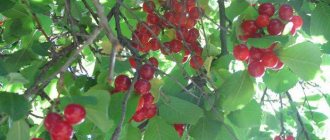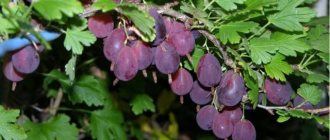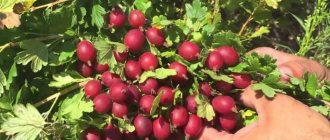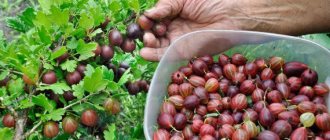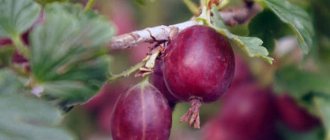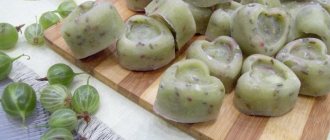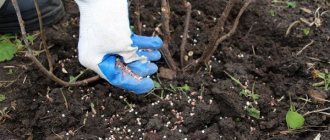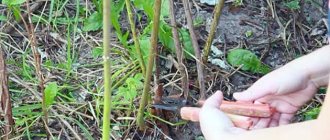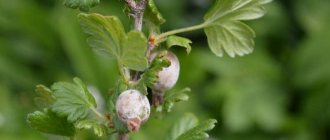Description of the variety
Spinefree gooseberries are classified as late-ripening varieties.
The bush is distinguished by powerful shoots reaching a height of 120 cm. The shoots are arched, covered with rich green large leaves. The bush is medium spreading with a spherical crown. The thorns on the branches are absent or very weakly expressed. During flowering (May), gooseberries look very decorative and brighten up the garden.
During the ripening process, the fruits change color from light green to dark red, with pronounced green veining. The berries are large, round, weighing 4-6 g. The taste is sweet with a slight sourness. Spinefree gooseberries are considered universal: its dessert fruits are used to make jam, jelly and other preparations, and are also consumed fresh.
Description of Spinefree gooseberry
The description of the Spinefree gooseberry indicates that the variety belongs to the late varieties. This is a tall plant; the photo shows that its powerful shoots reach a height of more than 1 m. The bush is moderately spreading, the crown is spherical, the branches are arched. They have virtually no thorns or very few of them, which greatly simplifies the harvesting process. The leaves of the bush are light green and large.
The Spinefree variety blooms in May. Gooseberries ripen at the end of summer. Its large fruits change color from green to dark red as they ripen. The weight of one berry is more than 4.5 g. The gooseberry is dense and does not crack on the branches.
Important! The Spinefree variety takes root well in any climate, so it is grown everywhere.
Drought resistance, frost resistance
The Spinefree bush easily tolerates the Russian climate. The shoots and root system can withstand temperatures down to -34°C. Gooseberries survive the drought period well.
Fruiting, productivity
The Spinefree variety bears fruit consistently and yields are above average. Gooseberries grow well in sunny places; they love the sun, so their berries do not bake under direct rays. During periods of prolonged drought, the fruits remain on the branches and do not fall off. Spinefree does not require special care or frequent watering.
The berries of the Spinefree variety have a good dessert taste. Gooseberries are loved by those who are tired of the sour fruits of other varieties. This variety has a predominant sweetness and a pleasant aftertaste.
The harvest is universal, easily transported, thanks to its thick skin. Gooseberries are used for fresh consumption, but they are also suitable for processing. Spinefree berries are used to make jams, jams, and jellies.
Advantages and disadvantages
The Spinefree gooseberry variety has many advantages over other varieties:
- fruits of universal purpose, excellent taste;
- shoots without thorns;
- bushes do not need shelter for the winter;
- the plant variety is easy to propagate;
- fruiting is stable;
- high transport characteristics.
However, Spinefree also has its downsides. These include the tall growth of the bush, the need for bright lighting and demands on the composition of the soil. Gooseberries will not grow in marshy and clayey soils. In the shade there will be few fruits, they will be crushed and the taste will deteriorate.
a brief description of
Spinefree gooseberry seedlings are a welcome purchase for many lovers of berry bushes, and here's why:
- The absence of thorns makes harvesting and caring for the bush much easier.
- The variety is extremely frost-resistant: it will survive when the temperature drops to -35 degrees, and is successfully cultivated in central Russia without shelter for the winter.
- Not affected by powdery mildew, high resistance to other diseases typical of gooseberries.
- Withstands prolonged drought.
- Consistently high yield.
- It grows well both as a single plant and in group plantings.
- Inexpensive seedlings found in many nurseries.
- Universal fruits with excellent taste characteristics.
The disadvantages include increased requirements for good lighting, sensitivity to drafts, intolerance to high humidity and waterlogged soils. However, these disadvantages are inherent to the culture itself and apply to absolutely all varieties.
With proper planting and careful care, there should be no problems with growing Spinefree gooseberries.
Landing
Requirements of the Spinefree variety for the place of cultivation:
- The area should be well lit - in shaded conditions the fruits ripen smaller and less tasty.
- The plant loves moderate humidity and unacceptably close groundwater (at least 150 cm to the surface of the earth). Excessive waterlogging can lead to rotting of the root collar.
- The soil is preferably loose, fertile, medium loamy. Clay varieties have a negative impact on the condition of the bush and its productivity; such soils must be improved before planting. Acidified soils (below 6.1-6.5 pH) are absolutely not suitable for growing the variety;
- Good drainage is required;
- The shrub grows well in ventilated places, but needs protection from cold winds.
The timing of planting seedlings on the site is spring (late March - April) or autumn (mid-September - early October). Autumn planting is preferable, young plants adapt better to new conditions, in addition, the period of spring planting is very short - you need to fit within the interval between the snow melting and the warming of the upper layers of the soil, but before the buds open.
The planting area is prepared in advance. The earth is dug up, weeds are removed, and holes are marked out. The distance between plants in a row should be 100-150 cm, between adjacent rows 150-200 cm. If the gooseberries are grown on a trellis or supports are installed around the bush, then the given dimensions can be reduced by 20-30 cm. The dimensions of the hole are 50x50 cm, depth 60 cm.
10 kg is added to each hole. rotted manure, 300 g of wood ash or 40 g of potassium sulfate, 150 g of superphosphate and 50-60 g of limestone.
A correctly selected seedling is the key to successful cultivation. The optimal age of a young bush is 2 years, height is 30-40 cm. The gooseberry should have 3-5 lignified skeletal roots (at least 10 cm in length) with a large number of fibrous roots and 2-3 shoots of 30 cm. Before planting you need to remove all dry roots, cut off the tops of the shoots, leaving only 5-6 buds.
How to care for a Russian Yellow
If the planting site is chosen correctly, the soil is fertile and the planting material was initially strong, care for Russian Yellow is minimal.
Watering
Gooseberries tolerate drought normally, however, with additional watering the harvest will be larger. The first watering is carried out in mid-May, and subsequent waterings are carried out once every two weeks. In this case, it is necessary to ensure that the ground under the branches is blown through. Excessive dampness can cause the development of fungal diseases.
Trimming
The crown of the Russian Yellow variety is not thickened. The plant forms naturally: the lower branches fall down, the bush seems to “open up”. This is both an advantage and a disadvantage at the same time. The lower branches, once in the ground, will quickly take root. Therefore, if you do not plan to propagate the gooseberry, it is advisable to raise it on supports.
Sanitary pruning is carried out in late autumn and early spring. Old and diseased, dry, fruit-bearing shoots are cut out.
When and how to feed
The Russian Yellow variety gratefully accepts fertilizing with organic fertilizers and complex mineral fertilizers. If organic matter is added to the hole when planting, you don’t have to worry about additional fertilizing for the first two years. When a plant develops poorly, it is supported with additional nutritional mixtures from the first year of life.
Watering with an infusion of May nettle brings good results. The freshly cut plant is compacted in a bucket or barrel, filled with warm water, covered with a lid and the infusion is allowed to ferment for a week. Before watering, dilute with water in a ratio of 1:5.
Adult gooseberries begin to be fed in early spring. Use an infusion of mullein (1:10) or chicken manure (1:20). Each bush requires one bucket of fertilizer.
During flowering, wood ash (a glass per bucket of water) and potassium sulfate (20 grams per 10 liters) will be beneficial.
In late autumn, superphosphate granules (30-50 grams per bush) are embedded in the root hole.
Treatment against diseases and pests
Effective pest control reduces the likelihood of berry diseases. Insects weaken gooseberries and carry many diseases, including such dangerous ones as viral mosaic.
In the spring, immediately after the snow melts, without waiting for the sap to flow, the gooseberries are sprayed with boiling water from a watering can, with baking soda added to the water (a tablespoon per liter).
In early spring, there is also a possibility of an attack on the Russian yellow from a spider mite. Without waiting for the cobwebs to appear, you need to spray the bush with garlic or onion infusion.
At the beginning of March, spraying with 1% Bordeaux mixture should be carried out, this will prevent anthracnose and rust. The period of action of the solution is 30 days. The procedure cannot be done during the period of fruit formation, since Bordeaux mixture is toxic to humans.
Preparing for winter
The Russian Yellow variety tolerates wintering well in the Moscow region, the Urals and Siberia. The structural feature of the bush allows the plant to remain covered under the snow all winter.
Preparation for wintering comes down to moisture-recharging watering and sanitary pruning of the bush. Young seedlings are covered with a thick layer of mulch or spruce branches. In the southern regions, gooseberries do not need additional shelter.
Growing and care
Watering
Spinefree prefers moderate watering for gooseberries. The frequency of moisture addition increases during the ripening period of berries, but should not exceed once every 7-10 days.
Trimming
Pruning Spinefree gooseberries is no different from standard pruning of other varieties:
- The bush is pruned in early spring, before the buds begin to bloom, or in the fall in October.
- Formation is carried out annually. Removal of excess root shoots is required; only 3-4 of the strongest annual shoots are left on the bush.
- All drooping branches, as well as damaged, dry and with traces of disease, must be removed.
- Branches 5-6 years old with weak growth (less than 15 cm per season) are completely cut out; part of them can be left until strong lateral branching occurs.
Top dressing
Spinefree gooseberries are fed according to the following scheme:
- For the first three years, gooseberries will need enough fertilizer applied during planting.
- From the fourth year, every autumn it is recommended to add 0.5 buckets of compost or manure, 40 g of superphosphate, 0.5 cups of wood ash under the bush.
- An annual application of nitrogen fertilizer, for example ammonium nitrate in the amount of 80 g per bush, will be useful. Nitrogen fertilizers are applied in the spring and in the first half of summer; later fertilizing with nitrogen will negatively affect the frost resistance of the plant.
- In early spring, gooseberries are fed with liquid organic matter. Feeding is repeated at the end of flowering and during the development of the ovaries.
Protection from diseases and pests
The Spinefree variety is not affected by powdery mildew and is extremely resistant to many other diseases. Regular preventive treatment with fungicides is not required.
Preparing for winter
Preparation for winter consists of pre-winter moisture-charging irrigation. 30-40 liters are applied to the soil. water. A moistened root system will endure winter more easily. There is no need to additionally insulate gooseberries, since their frost resistance indicators are extremely high. In winters with little snow, you can throw snow around the trunk.
Features of agricultural technology
Growing agricultural technology includes planting and caring for the plant. All procedures should be carried out using technologies recommended by agronomists. Otherwise, the shrub will grow poorly, bear little fruit, or even die.
Selecting a location
A site for growing Spinefree gooseberries must meet a number of criteria:
- lighting should be bright, complete absence of shadow is recommended;
- it is better to protect the site from sharp gusts of wind with the help of a high “blind” fence;
- choose an elevated area where moisture will not stagnate after rains;
- groundwater must be at a depth of at least 1.5 m from the surface of the earth;
- soil with an acidity of 6.5 pH;
- The optimal soil type is loose loam.
In clayey and swampy soil types, the crop will grow and develop very poorly.
Planting and care, pollination
Planting is carried out in autumn or spring:
- in the second half of September - first half of October;
- in the last days of March or April.
In central Russia, autumn planting is preferable. Plants planted at this time take root better in their new location. Before planting, the area should be prepared. To do this, it is dug up and weeded. Planting is carried out as follows.
- Dig holes 0.6 m deep and 0.5 m wide. The distance between bushes should be 1-1.5 m, between rows - 1.5-2 m.
- Pour 50 g of lime, 300 g of ash, 150 g of superphosphate and 10 kg of manure into each hole.
- Trim the tops of the branches of the seedling to 5 buds.
- Place the planting material into the holes.
- Fill the free space with fertile soil. Compact it.
Spinefree is a bisexual, self-pollinating gooseberry. Planting pollinator plants is not required. Watering is carried out as the soil dries out. The maximum frequency of irrigation is once every 1-1.5 weeks. We must not forget about watering during the ripening of the crop - during this period the plant especially needs moisture. To achieve abundant fruiting, shrubs should be regularly watered and fertilized.
You may be interested in information on how to deal with lichen and moss on gooseberries.
The bushes do not need to be fertilized for the first 3 years after planting. Then fertilizing is applied annually according to the following scheme (per plant):
- at the beginning of the growing season - liquid organic products;
- from late spring to early summer - 80 g of ammonium nitrate;
- when setting fruits - liquid organic products;
- in autumn - 5 kg of compost, 100 g of ash, 40 g of superphosphate.
Video: How to plant gooseberries correctly
Disease and pest control
The culture is resistant to most diseases and parasites. Preventative treatments are not required. To protect against potential problems, timely and high-quality care is sufficient.
Did you know? Gooseberries are a close relative of black currants. A hybrid of gooseberries and black currants is called yoshta.
Pruning and shaping the bush
In order for the fruits to ripen evenly and be fully saturated with plant juices, the bush must be shaped. Pruning is carried out in the spring before the growing season begins. If necessary, the procedure can be carried out in the fall, when active development processes slow down. For successful formation, gardeners remove branches:
- old;
- broken;
- growing inside the bush;
- with a gain of less than 15 cm at the age of 5 years
You also need to completely cut out the root shoots.
Wintering
The variety can withstand frosts down to –35°C. Shelter for the winter is not required. Preparation for wintering includes moisture-charging watering - at the end of the growing season, 3-4 buckets of water are poured under each bush.
Important! Berries affected by plaque or rot cannot be stored together with healthy fruits. Damage can signal fungal diseases that can “spread” to the rest of the crop.
Reproduction
Gooseberries of the Spinefree variety reproduce vegetatively. It is most convenient to use root shoots for this purpose. When they come into contact with moist soil, they take root very quickly. Young plants are suitable for producing layering; adults are propagated after the rejuvenation procedure.
How to propagate a plant:
- In early spring, small trenches are dug around the trunk.
- The shoots are bent to the ground without being separated from the main bush. For stability, they are secured with wire pins and sprinkled with earth.
- When young branches up to 10 cm in length form on the shoots, they are hilled up and watered.
- Watering is repeated every 5-7 days. To retain moisture, the soil is mulched.
- Root shoots take root by autumn and can be transferred to a permanent place.
Description
The cooperator has strong “parents”: these are “Chelyabinsk Green” and “Smena”. Bred by scientists of the South Ural Institute specifically for cultivation in the central regions of Russia. Officially entered into the register in 1999.
An adult plant looks neat and compact. The branches extend up to 120 cm in length. Young shoots are light green, pubescent, and medium in thickness. More mature branches in the lower part give off a pinkish-crimson tint. The leaves are large, very beautiful, green with a waxy sheen. The five-lobed shape of pointed leaves with edging in the form of the smallest “fringe” looks very impressive.
On the branches, mainly in those places where there are no longer fruits, there are single thorns. The berries are large, elongated, burgundy, almost black, each weighing at least 3-5 grams (maximum weight up to 8 g). The skin is thin, durable, without edge. The fruits taste sweet and sour, pleasant.
In terms of ripening time, Kooperator belongs to the mid-late varieties. 4-8 kg are removed from one bush. berries (12-23 t/ha). The plant is resistant to sawfly and powdery mildew.
Reviews
In my opinion, Spinefree is one of the best varieties among thornless varieties. I have already planted several other thornless varieties, but the berries were small and the yield was much lower than that of conventional varieties. Spinefree captivated me with its high yield, wonderful aroma and sweet taste. I bought it three years ago in an online store for 250 rubles. Compared to other varieties, it was not expensive, for example, Kolobok and Grushenka were much more expensive. The bush began to bear fruit already in the second year after planting, which I also consider a significant advantage. Old varieties, even after partial freezing, were restored only for 3-4 years. The only thing I don't like is the late ripening period. I would like to feed my grandchildren berries when they are with me during the hottest season, and Spinefree begins to bear fruit when everyone has already left. For these purposes, I dream of planting Ksenia, which bears fruit in June, but I have not yet found where to buy seedlings.
The Spinefree variety can be called ideal in many respects. Gooseberries require standard care rules; their thornlessness makes the gardener’s work easier. A variety of dishes are prepared from the fruits - from preserves and jams to berry marmalade and homemade wine.
Reviews from summer residents
Gardeners leave positive reviews about the Spinefree variety.
Valentina, Moscow region: “We bought a dacha about 10-11 years ago, started planting the plot, and I decided to plant gooseberries. We don’t have much space, so I chose a self-pollinating variety so that I wouldn’t have to plant other varieties. In the end, I bought Spinefree and have never regretted it. The bush is large and very beautiful, especially during flowering, it bears fruit consistently and the harvest is rich. The berries are large and tasty. We don’t have time to eat them fresh, so I put some of them into processing - the jams and preserves are simply delicious.”
Margarita, Bryansk region: “For me, this is the best variety of gooseberry. Yes, it is demanding on watering, lighting and sun, but I do not consider this a serious drawback. It is enough to choose a suitable place on the site and take responsible care of the bushes. But the yield is high, fruiting is stable, and the berries are very tasty. At the same time, Spinefree is also not afraid of frost, does not get sick and is not affected by pests.”
